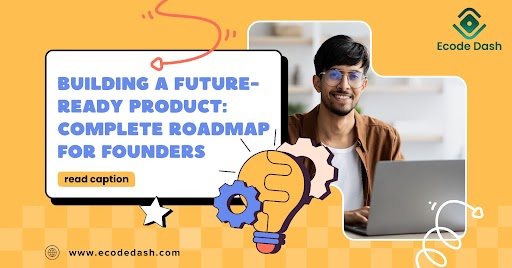
Hey founders, today’s product lifecycles are shortening while user expectations are rising and building a future-ready product is about more than just innovation, it's about intentionality. For founders like you, a strong roadmap is your compass, helping you go through the uncertainty with clarity.
Hear us out..! Everything begins with a clear product vision. It's a practical guide that aligns your strategy and defines how your product addresses real-world problems.
Once that vision is in place, founders should set SMART goals. Objectives that are specific, measurable, achievable, relevant & time-bound. As you scale, these broader goals should be broken down into actionable initiatives and user stories that fit within an agile roadmap. Unlike rigid timelines, agile planning embraces frequent iterations & feedback loops, helping teams stay responsive to market & user needs. Most importantly… measure your progress based on every outcome.
Founders need to foster a culture where cross-functional teams collaborate closely… from design & development to marketing and customer support because behind every successful product is a team that’s aligned & empowered.
It’s not enough for leadership to know where the product is going; every team member, from junior developers to product marketers, should feel connected to that journey. Empowering teams with ownership, rather than micromanagement, fuels innovation and accountability. Clear communication, regular check-ins & also the right tools for project management and knowledge sharing can make a world of difference in maintaining transparency and momentum.
The foundation of a truly future-ready product lies in deep customer understanding. Founders must involve customer research into every stage of the product lifecycle, not just before launch, and this involves regularly speaking with users, analyzing behavior, running usability tests & collecting structured feedback. Surveys provide invaluable insight into what customers truly need.
IPrioritizing features should always be guided by this understanding. Frameworks like MoSCoW or RICE can help ensure that development efforts align with user value and strategic goals. Also keep in mind… true customer-centricity also means staying in a mode of continuous discovery, constantly listening & iterating based on real feedback.
The technology choices you make today can either empower your growth or hinder it down the road. A modular architecture allows your product to evolve without needing to be rebuilt every time new features are added or markets shift. This doesn’t mean chasing every new trend but it does mean staying informed about emerging technologies and integrating them where they add real value.
Alongside scalability, security and compliance should be baked into your design from day 1. Your product should also be built to integrate easily with other platforms, anticipating the growing demand for seamless, interconnected tools. Even if you’re starting locally, consider future global needs that is multi-language support, region-specific user experiences & cultural design considerations that can really save massive time & effort later.
The most successful products are not the ones that launch flawlessly, they’re the ones that keep improving. To stay competitive, teams must create systems for ongoing learning. That starts with structured feedback loops involving users, team members & stakeholders.
Data has a critical role here but it’s not about drowning in dashboards. It’s about identifying meaningful metrics those tied to user engagement, retention, conversions and hence using them to guide decision-making. Regular product reviews, be monthly or per sprint, whatever you are comfortable with, help teams stay aligned and responsive. More than anything, cultivating a culture of experimentation gives you permission to try new things & pivot quickly when something doesn’t work. It's all about learning fast & not failing fast.
Finally, future readiness means thinking beyond product development and focusing on how your solution reaches and retains the right users.
Founders should define their GTM, i.e., go-to-market strategy early and ensure it evolves alongside the product. You have to identify your target audience, refine your messaging & select acquisition channels that match user behavior. A compelling brand narrative, one that communicates who your product is for and why it matters. Don’t underestimate the power of your earliest users… when engaged & supported, they can become your most passionate advocates. A focus on long-term value delivery ensures your users keep coming back & back.
For a future-ready product, stay grounded in what truly matters: your users, your mission & obviously your adaptability. The journey won’t be linear and it won’t be easy but with the right foundation, your product can do more than survive change. It can lead through it.
At Ecode Dash At Ecode Dash, we partner with founders who are ready to build boldly. From idea to MVP to scale, we help turn your vision into a product that makes real impact, today and in the future. Book a free strategy session with Ecode Dash now…
Also Read: Stages of Product Development Process: From Idea to Launch in 2025